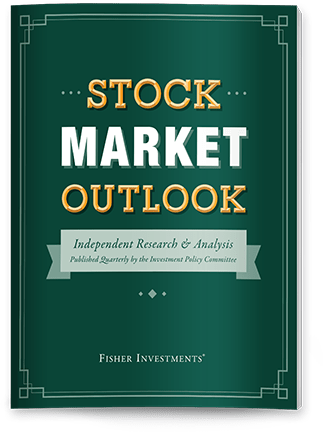Personal Wealth Management / Expert Commentary
Fisher Investments Reviews its 2024 Midyear Outlook
Fisher Investments’ founder, Executive Chairman and Co-Chief Investment Officer, Ken Fisher, discusses his outlook for stocks for the rest of 2024. Ken acknowledges short-term market forecasts are difficult, but believes the back half of the year will feature strong returns. Ken says the back half of presidential election years have historically benefitted from fading political uncertainty when a winner emerges. While 2024’s election is somewhat unique due to our familiarity with the candidates, Ken expects this trend to hold, albeit to a potentially lesser extent.
In Ken’s view, another market tailwind is the underappreciated strength of the US economy. He says inflation is decelerating and nearing the Federal Reserve's 2% target, which should buoy investor confidence. While Ken admits stock volatility can strike at any time, he thinks fading political fears against a healthier-than-appreciated economy should help boost stocks.
Transcript
Ken Fisher:
Get to a year like this—year starts off pretty well. You approach mid-year, people ask all the time what do you think will happen in the back half of the year? So let me speak out of both sides of my mouth a little bit. First, the short term forecast that you make for stocks, or any capital market for that matter, the more foolhardy it is in the short term.
Stocks are volatile, they just are, so you can get a lot of bouncing around. You could in the back half of a year—and I've seen this plenty of times in my life— get the market going both ways fairly big time and end up real different than anybody would have thought when the first big move in the six months happened.
Overall, my view of the back half of the year is that it will be strong. Why? Well, let me give you a couple of rules of thumb. One, as you've probably heard me say before, if you pay attention to things that I say repeatedly, repeatedly, repeatedly the fourth years of a president's term tend to be strong.
The history of that's pretty overwhelming. Not perfect, like third years of president's terms, but pretty strong. The back half of them historically tends to be stronger than the first half. Why? Well, why is always the toughest thing to answer. What? When? How? Who? Those are all easier ones to do than why? But my sense is that in a presidential election year we always have these two people. Both sides fear the other side will win. There's uncertainty about all that.
In the end, every time—and I've studied this—somebody wins. We always get a winner, and that winner we tend to like more than we thought we would earlier on. Maybe not a lot, maybe only a little, but that's how they win. And as that happens uncertainty falls, because we get a winner, and the uncertainty falls in favor of us liking the winner overall a little bit more than we thought we would. And that helped buoy stocks up as uncertainty falls.
Now, I'm going to say in this particular election, by just going off on a tangent for a moment, it may be that there's less of that than normal because we've known both of these two major party nominees better than we've known any two nominees in over 130 years.
The fact is that whether you like or loathe either one of these two men, the election mostly ends up being determined in one like this where the polling numbers are very close between them. We know them both so very, very well, and yet there's still a fair amount of undecideds. It's probably decided by how undecideds shift at the last minute, and undecideds tend to shift at the last minute.
And as they do that, they tend to shift to someone that they think of as less worse, whatever that means to them. And that makes them like the winner more, so we probably get some of that.
We probably get less of that than has often been the case when we've, for example, had an open race and we didn't know either of the two nominees as well as we know these two men, or we had one incumbent that we knew pretty well but one challenger who we knew less well.
So I think we may get less of that, but I would expect the back half of the year to have falling uncertainty politically, and that'll help stocks.
The economy is stronger than people think. Then there's a conundrum that also I don't think gets priced in quite fully, which is is that the average American thinks of inflation differently than the central bank that controls what happens with monetary aggregates— think of inflation. The average American thinks of inflation like, wow, look at that. Prices are way higher than they were in 2021. And that's true.
The central bank, the Fed thinks about it as what's the ongoing inflation rate now, which, you know, now as we speak it is about 3.5%. And their goal is to have it be about 2%. Their goal is not and never was and never would be to reverse prices back to the lower levels that existed once upon a time.
Their goal is to end the future inflation rate above 2%. And so as we move toward the end of the year, they get closer and closer to their goal. They don't get closer to the goal of the average American, which is to see pricing go back down, which particularly hurts the, more or less to a rounding error, lower 30 to 40% of the US income spectrum more than it does the wealthier and higher income people. But because it's the lower 30 to 40% of the income spectrum that it hurts the most, it also has less impact on capital markets.
So I think as we move through the end of the year and the central bank gets closer to its objectives, that that becomes seen as more bullish, the economy continues to be okay. We move further and further away from the world we were in last year where people were scared to death of all kind of terrible things in the economy happening, and we get a winner in politics.
Likewise, the overseas world is relatively benign. We should have a good back half of the year. Is that certain? No. I'm just going to say to you really simply that the market can drop off of some crazy story that never materializes into reality by 20% in three months and then bounce back the same amount three months later.
And that could happen, you know, just at the very end of the year and take away all the return because stocks are volatile. And in some ways thinking about the calendar year function—start point, end point—of how you measure returns is a little too cute by half in that it's really the longer term phenomena that matters and not what really matters come this December 31st. Thank you for listening to me. I hope you found this educating and useful and not too much painful.
Voice of Ken Fisher:
Subscribe to the Fisher Investment YouTube channel, if you like what you've seen. Click the bell to be notified as soon as we publish new videos.

Where Might the Market Go Next?
Confidently tackle the market’s ups and downs with independent research and analysis that tells you where we think stocks are headed—and why.




